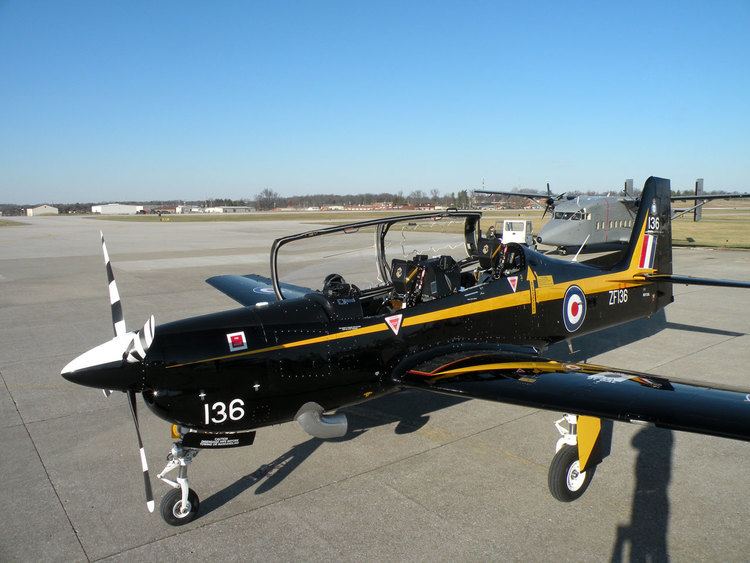Top speed 507 km/h Wingspan 11 m Length 9.855 m First flight February 14, 1986 | Range 1,665 km Cruise speed 407 km/h Engine type Garrett TPF351 | |
 | ||
Rc short tucano modelpark such 2014
The Short Tucano is a two-seat turboprop basic trainer built by Short Brothers in Belfast, Northern Ireland. It is a licence-built version of the Brazilian Embraer EMB-312 Tucano. The main operator is the Royal Air Force with exports to Kenya and Kuwait.
Contents
- Rc short tucano modelpark such 2014
- Short tucano t1 start up
- Origins
- Production
- Operational history
- Accidents and incidents
- Variants
- Operators
- Specifications Tucano
- References
Short tucano t1 start up
Origins
Development of the Tucano started in May 1984 after an agreement between Embraer and Short Brothers to meet a requirement to replace the BAC Jet Provost as a basic trainer with the Royal Air Force. The Royal Air Force issued Air Staff Target 412 to define the requirement for a high-performance turboprop trainer. A shortlist of designs competed for the contract; the other types considered were the Pilatus PC-9, the NDN-1T Turbo-Firecracker and the Australian Aircraft Consortium (AAC) A.20 Wamira II.
In 1984 Embraer sent Shorts the seventh EMB-312 airframe off the production line for modifications in order to meet AST-412 requirements. The type was displayed in September 1984 at the Farnborough Airshow featuring an uprated PT6A-25C2 engine and a ventral air brake to meet required stall speed of 60kt. However, tests undertaken at Boscombe Down later on that year indicated the need to re-engine the aircraft (to meet the RAF requirement for time to height) and the Garrett TPE331 was chosen.
On 21 March 1985, the Short Tucano proposal was declared the winner of the AST.412 contract worth £126 million for 130 aircraft and an option for a further 15. The first flight of the prototype EMB-312G2 which featured a four-bladed Hartzell propeller with the Garrett TPE331-10 engine took place in Brazil on 14 February of the following year, the aircraft being then disassembled and airlifted back to Belfast on 29 March 1986 to fly again just ten days later. In June, the TPE331-10 engine was replaced by the TPE331-12B, a major difference being the integration of an Electronic Engine Controller (EEC) system.
Production
The first standard production model T.Mk 1 was flown on 30 December 1986 and the official rollout took place on 20 January 1987. A second prototype flew on 10 March 1987, and, by April a third had joined the test fleet for clearance and final testing at Boscombe Down. The fourth build aircraft was the first delivered to the RAF on 16 June 1988 at the Central Flying School, while the last delivery to RAF occurred 25 January 1993.
In addition to the primary order from the RAF, export customers emerged for the Shorts-produced Tucanos. The Kenyan Air Force ordered a total of 12 units, a further 16 Tucanos were exported to Kuwait as well. The Tucanos serving in the Kuwait Air Force were furnished to be armed and combat-capable for the purposes of weapons training and light attack duties; each aircraft features four pylons capable of mounting various rocket pods, cannons, bombs, and auxiliary fuel tanks.
In addition to the revised engine, the major differences of the Shorts Tucano are a strengthened airframe for an improved fatigue life, a cockpit layout similar to the Hawk advanced trainer, a revised oxygen system, a flight data recorder, a four-bladed propeller, ventral airbrake and restyled wingtips. Two Martin-Baker MB 8LC ejection seats are used and the canopy was modified to meet the RAF's bird strike requirements. During its production run, Shorts commonly promoted the airframe as being "100% British-built". In order to meet RAF requirements, the EMB-312 has some 900 modifications reducing commonality with the original aircraft to only 50%
Operational history
Since first deliveries to the RAF in 1989, the Tucano has been operated primarily from No 1 Flying Training School at RAF Linton-on-Ouse to provide basic fast-jet lead-in flying training to RAF and RN student pilots. The deployment is officially to 72 (Reserve) Squadron, 207 (Reserve) Squadron and 76 Squadron (Tucano Air Navigation Squadron). Student pilots fly around 130 hours during their training course on the Tucano before progressing to the Hawk T1 aircraft at RAF Valley.
The Short Tucano replaced the Jet Provost as the basic trainer for the RAF, preparing the student pilots for progression to Hawk T1 advanced flying training. The aircraft proved to be 70% cheaper to operate than its predecessor. The Tucano's accident record has also been remarkably better than other ab-initio training aircraft, with only three aircraft written off in over 20 years.
In March 2007, regarding experiences from the War in Afghanistan, the British Parliament was debating the idea of replacing Harriers and Tornados for armed Short Tucanos during close air support missions. This would have required extensive modification as the RAF aircraft were not fitted with wing hardpoints.
RAF has a contract with VT Group to support maintenance until April 2014, with possible option to extend the deal for another two years. The aircraft was scheduled to be withdrawn from service in 2015. It will be replaced by the winner of the UK Military Flying Training System (UKMFTS) programme.
Accidents and incidents
On 22 June 2015, two-time Academy Award-winning composer James Horner died when the Tucano he was piloting crashed in central California in a remote region of the Los Padres National Forest about 60 miles (97 km) north of Santa Barbara. Horner was the sole occupant of the plane.
Variants
Operators
Specifications (Tucano)
Data from Jane's All the World's Aircraft, 1988–1989
General characteristics
Performance
Armament
